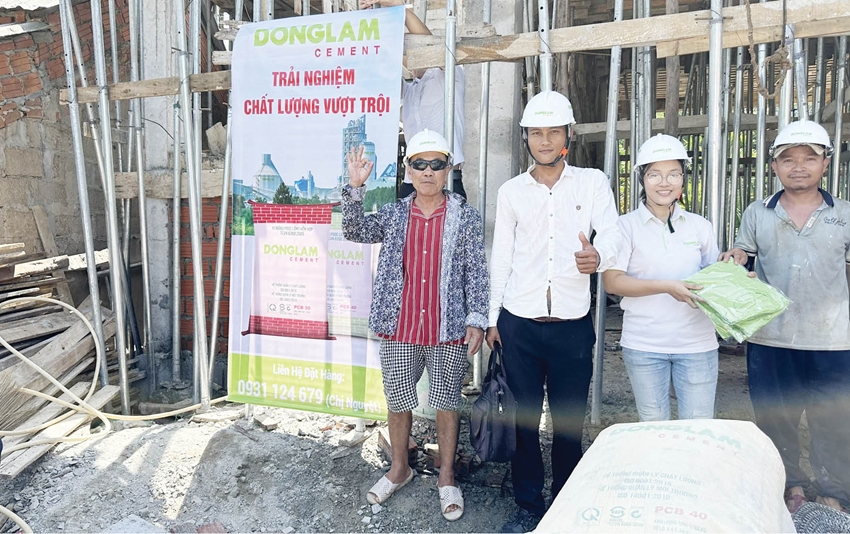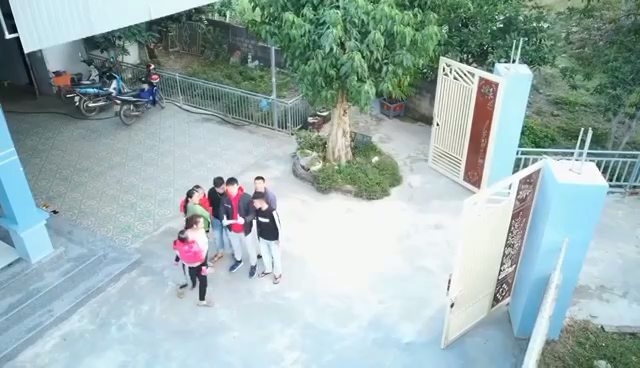 |
| Experience the quality of Dong Lam cement at the foot of the construction site |
Reinforced concrete is a harmonious combination of concrete and steel to help increase the compressive and tensile strength of the concrete structure. To have a reinforced concrete structure that creates a quality construction, preparation, construction, and maintenance are all very important.
First, the preparation and construction of the support columns and formwork must be ensured. If not careful and secure, it can easily lead to risks such as subsidence of the foundation, collapse of the scaffolding during construction, or can cause the concrete to sink, swell, shrink in size or lose cement water during the pouring process, causing the concrete block to crack.
To prepare for mixing concrete mixture, it is necessary to select sand and stone materials to ensure suitable grain composition, no flat grains, no harmful impurities (mud, dirt, organic impurities). Sand and stone with too fine grain composition will increase the risk of cracking due to plastic shrinkage, reduce the strength of the structure and waterproofing. The impurity content in sand and stone reduces the adhesion, reduces the strength of concrete and mortar and causes a high risk of seepage.
Concrete mix must be optimized for each use and designed most appropriately, as well as must meet the required concrete grade at the site and at the commercial concrete station. The amount of sand, stone and water mixed must be in the correct dosage.
With the same mix of cement, sand, and stone, the amount of water used is more or less to adjust the slump (mobility) of the concrete mixture for ease of construction. However, slump that is too low or too high can affect the quality of the concrete. Therefore, the slump needs to be adjusted appropriately for each construction item. Accordingly, the slump of the concrete mixture used for reinforced concrete floors is usually about 10±2 cm (maximum 12±2 cm when elevated) when using a concrete pump; the reasonable slump for foundation concrete poured directly without a pump is 6±2 cm; the reasonable slump for columns and floors poured directly without a pump is 8±2 cm.
Depending on the function of the floor or the floor area, the floor concrete can have different thicknesses. Ensuring the thickness of the floor concrete helps the floor to bear the load better, promote the function of the steel reinforcement and protect the steel reinforcement. For each item, the thickness of the concrete layer protecting the steel is different, usually the concrete layer protecting the steel of the floor and beam is not less than 2cm. If the concrete layer is too thin, it will reduce the load-bearing capacity of the floor and beam.
When pouring pumped concrete, there are some notes to avoid as follows: First, do not let the concrete mixture fall too high, which will cause stratification and separation of concrete mixture layers on the floor, affecting the quality of the floor concrete; the falling height should not exceed 1.5m. The concrete pouring process must be continuously and evenly compacted throughout the pouring location to ensure a uniform, solid concrete layer, avoiding honeycombing. The compaction time at each location, the distance between compaction locations are different and depend on the capacity of the compactor, the thickness of the floor, and the beam.
If the tamping time is too short, the concrete mixture will not meet the requirements; if the tamping time is too long, the concrete mixture will be stratified, large aggregates will settle to the bottom, making the concrete mixture inconsistent. The floor surface must be finished as the tamping is completed. The process of pouring floor concrete must be poured from far to near compared to the concrete receiving position to limit people and vehicles moving on the newly poured concrete structure.
Curing concrete after pouring is very important. Proper curing ensures that the concrete remains moist and avoids adverse effects during the initial curing process. Improper curing can cause cracks on the floor surface and white concrete surface.
The curing process should be carried out in the following steps: After pouring and surfaced concrete, it should be covered with a plastic sheet to avoid direct sunlight and rain and also to keep the concrete moist. After the concrete has set (about 3-4 hours), let water flow gently and evenly over the floor surface, ensuring the entire floor is wet. On the first and following days, avoid walking or physical impact on the concrete.
On the third day after pouring concrete, some effective maintenance methods can be applied, such as building a border around the floor and storing water to maintain the floor. This method was used by our ancestors and is very effective in maintaining the floor and preventing cracks. Cover the entire floor surface with a layer of burlap or straw and water it many times a day. Spray water and maintain continuously for the first 7 days to keep it moist, with a frequency of 3 hours/time, at least once at night. After that, maintenance needs to be maintained regularly for as many days as possible until the concrete block reaches quality.
Source: https://baothuathienhue.vn/kinh-te/xay-dung-giao-thong/thi-cong-dam-bao-tuoi-tho-ket-cau-be-tong-147337.html






















































![[Maritime News] Container shipping faces overcapacity that will last until 2028](https://vphoto.vietnam.vn/thumb/402x226/vietnam/resource/IMAGE/2025/7/30/6d35cbc6b0f643fd97f8aa2e9bc87aea)













































Comment (0)